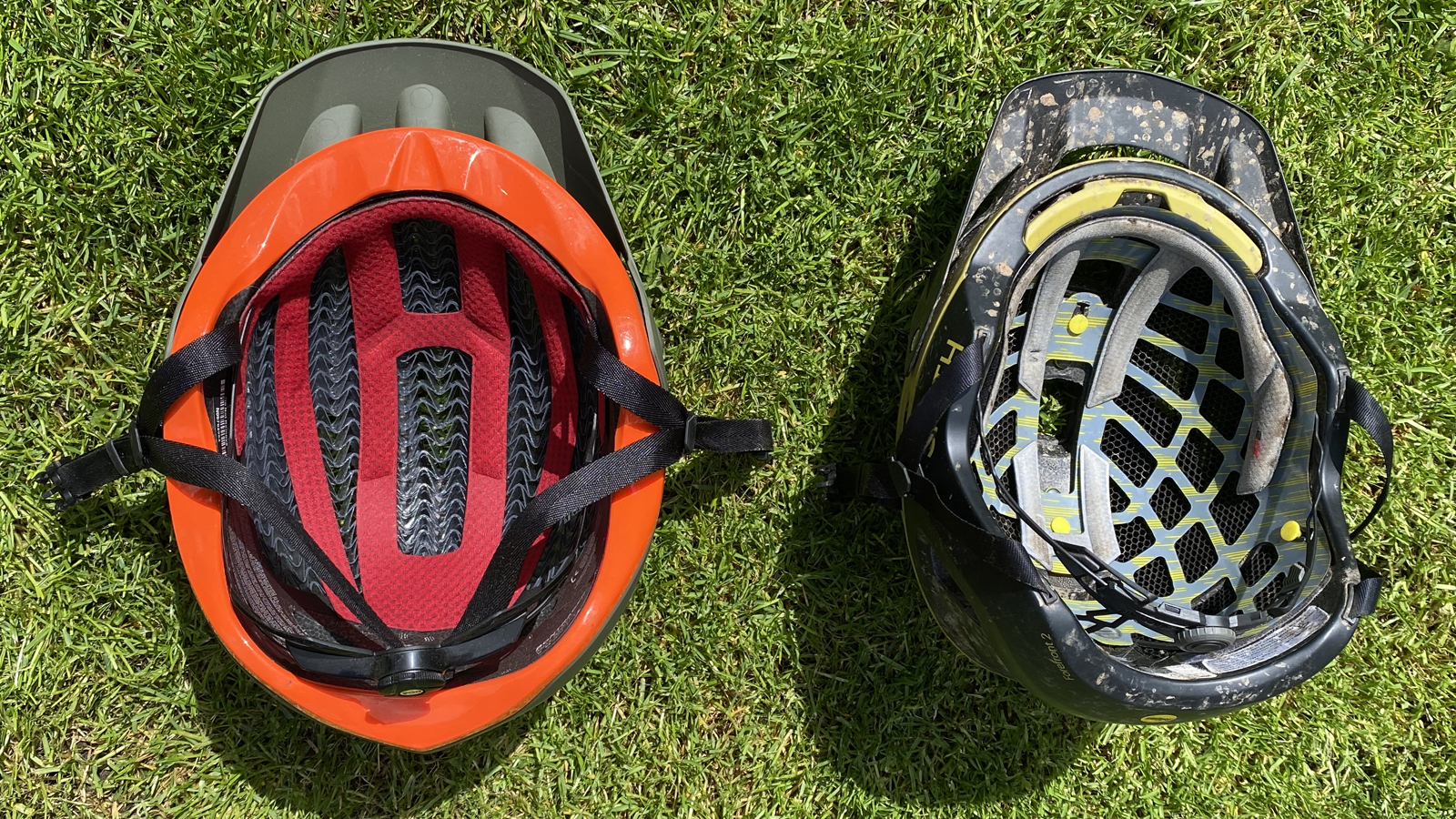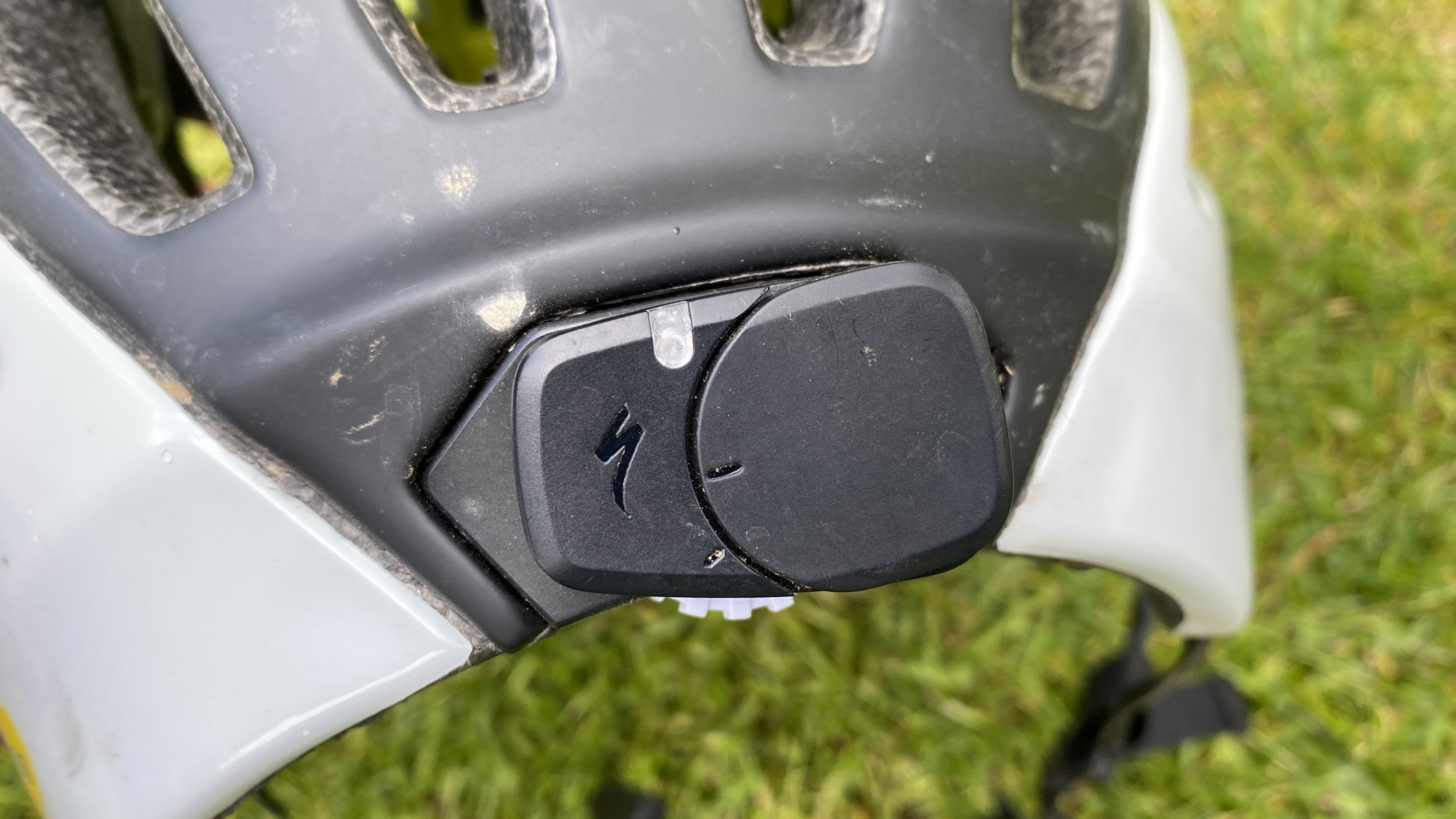Bespoken Word: Heads up
Guy Kesteven has been accidentally smashing bike helmets since the 1980s, but what does all the tech and acronym hype mean when you’re choosing a lid?

You can’t sell a bike helmet in the UK without it meeting the legal safety requirements, but are those standards and other tests even relevant, and how do you choose a helmet that will properly protect you while still working for the riding you do?
Firstly, one thing I’m not going to argue about here is whether or not you should wear a helmet. I get that some people see putting a few hundred grams of polystyrene on their heads as a gross invasion of their civil rights. And while I’ve seen airflow tests that say wearing a helmet is actually cooler at speed than not wearing a helmet, that’s definitely not the case if you’re chewing uphill on a summer's day in a limited ventilation full-face. If that’s your choice though, then I’m not going to be comfortable riding with you or having to call your relatives to explain how you thought the feeling of air rushing through your hair was worth the risk of the feeling of blood trickling down your scalp from a life-changing injury. Because let’s face it (pun intended) if you turn yourself into roadkill from the neck up then you’re probably not the one who has to get you off the trail to a hospital, it's the people you ride with, or who find you.
- Best mountain bike helmets: the best MTB helmets from XC, trail to enduro
- Best half-shell mountain bike helmets: open face helmets for trail and enduro riding
I’ve broken enough helmets to know that I almost certainly wouldn’t be typing this without them. Memorable impacts range from watching the world tip 90 degrees in slow motion as the chain jammed on my road bike trying to outsprint a Honda Love moped off the lights on Blossom Street in York. And then watching that pink moped and the tasseled white cowboy boots of its pilot (no doubt pissing themselves) pull away as my ear skimmed the road surface when my vast and hideous Kiwi K35 (seriously Google it, it even had a slide down face visor) took the brunt of the long slide into the bus stop at the Odeon. The peel of pink leather I left down the road took weeks to heal but my head and its contents were fine.
Or the time I looked across jubilantly to top UK downhiller (and now pro stuntman) Rob Jarman on the first day of a trip to Chamonix and the Mega Avalanche. Brimming with adrenalized pride that I’d overcome my terror of telecabin vertigo and was off the brakes and upfront with the fastest fellas. Rob’s look of sickening disbelief as he looked back and silently formed the word “nooooooooooooo” will still be vivid in the nursing home, as will the flick-book images of the rock field turning from brick to microwave size, the first stinging impact before a startlingly long flight upside down with my ankle wedged between crank and forest green Santa Cruz Bullit (the second generation one with the lousy pivot placement) and then the sudden, air-evacuating slam into a concrete drainage ditch.
As the dust settled, my ankle was screwed; I’d smashed a few more ribs and had a Dainese tattoo on my shoulder that lasted a couple of months. Despite being inside a full-face lid I’d broken a couple of teeth from the force my jaw had slammed together, but somehow the rest of my skull was fine. I could throw in at least five more serious crashes where a helmet has saved me from serious, lasting injury or worse, before I even start on the similar incidents I’ve seen but you get the idea.

Justifying the need to wear a helmet is easy. What’s sometimes harder to work out is what protection you need, what the various technologies mean and how relevant the testing is?
You don’t have to wear a helmet in the UK while you’re cycling, but a lot of events and facilities make it mandatory. The basic legal standard for safety is EN or BSEN 1078 (1080 is a supplemental kid's helmet standard). In the US, it's the Snell B-90 or B-95 standard or ASTM F1952-15 for DH. Interestingly that doesn’t stipulate a full-face design, but if the helmet does have a chin guard that has to pass the test. There’s a new European NEN NTA 8776 standard for e-bike helmets too, which is slightly tougher than 1078, as it’s presumed you’ll be going faster with a motor.
Most of these standards involve strapping helmets onto a metal head-form with accelerometers to measure transferred force and then dropping them onto either flat or right-angled (to simulate curbs) metal anvils. Other tests involve the extent of movement when the helmet is jerked at an angle to check it doesn’t shift more than 30-degrees from its intended position in a crash.
It’s important to note that these rather crude tests are the bare minimum, and most reputable manufacturers test well beyond these standards in their own labs. I’ve been shown around the lab at Giro in California and it’s genuinely like the workshop of Q from James Bond, with a huge number of different testing stations ranging from the Snell/CEN rigs to impact sleds, thermal sensing head-forms to check venting, and a whole lot of other gear they asked me not to talk about.

The changes in mountain biking have been reflected in helmet design, too. Back in the early '90s, it was all about minimal weight for XC racing and the Specialized Sub 6 was king: a block of raw polystyrene perched high on your head with barely any side or rear protection.
I had a Vetta Testarossa that was similar, apart from the fact I cut the middle out of it so I could stick my mohawk through. Thankfully that was one of the rare ones I never crashed hard in before it fell apart from natural causes.
Etto helmets were a bit more protective as they had screws on the outside that let you ‘grow’ them to fit your head, but would crush your skull like King Kong’s fist when those screws slipped. Giro’s Hammerhead and Bell’s Image (extra cool because Tomac wore one) introduced the idea of a plastic cover to help helmets slide rather than stick when you crashed and the Giro Terramoto had a small peak and the first “Roc Loc” cradle to dial in fit. The really rad riders were already wearing MX-style Shoei helmets with properly big peaks and extended shells right down to the neck and nearly the jaw. I can’t quite remember when downhillers started wearing full-face lids rather than an open face and an MX mouth guard (thanks for that look, Philippe Perakis) but after they appeared - just like bike geometry - nothing much changed for the next three decades.
- Best XC and marathon helmets: cross-country and marathon helmets to give the racing advantage
- Best full-face mountain bike helmets: ultimate head protection for serious gravity riding
That was when snow sports companies such as POC and others got involved in the MTB scene and brought with them a new breed of rotation-reducing technologies. MIPS (Multi-directional Impact Protection System) is the big name here and justifies extra cost and ventilation complication with data showing how much a sliding inner skin between head and lid significantly reduces the amount of rotational load - and therefore potential concussions and axonal or subdural hematoma injuries - on your brain in a crash. There are other similar technologies - such as Turbine 360 from Leatt, SPIN from POC or the two-helmets-in-one MIPS Spherical designs from Giro - that have jumped onto the cerebellum suspension bandwagon.

The way helmets are made has also seen some big changes. While most designs still use a high density expanded polystyrene (EPS) throughout, some designs like the Giro’s Tyrant and Manifest use different densities of EPS and EPP to reflect the likely impact load in each area. Smith pioneered the use of tubular Koroyd cells to provide the collapsing, load-absorbing element of its helmets and Endura has followed suit. Bontrager has developed its helmets around WaveCel which unsurprisingly use a waveform deformation material.
It’s right about now where things really get complicated though, because all of these technologies are well beyond the current safety standards and into an area where there are no official points of guidance for the consumers or hard data to compare different products with.
In Bontrager’s case that means it's currently having to defend a lawsuit against its alleged claims of the WaveCel being 48 times more effective against concussion than conventional foam helmets. It's also fallen out with MIPS - whose liners it used to use before WaveCel. Another relatively recent independent study by Swedish test firm Folksam commissioned by the Road Safety Trust informed recommendations on helmets that performed ‘better than average’ across five tests.
That sounds fair enough, but when you look at the 27 helmets tested it’s a real mixed bag. Again that’s fine, but when the only full-face helmet on the test - Bell’s £275 Super Air R - actually offers fractionally less protection on their results compared to the £55 Bell Trace all-rounder, you start to wonder how relevant the test was. Other oddities include Specialized’s Prevail road helmet scoring better than its Ambush MTB helmet and the Bontrager MIPS helmet being within three per cent of the Wavecel helmet.
At this point, we either have to wait until someone invents a new testing standard for helmets that are more thorough than just dropping them on steel edges at specific angles (which is easy to design around) or you just have to apply common sense. A helmet with extra coverage is more likely to protect you from more angles of ground attack than a shallow road helmet, while choosing a full-face will hopefully mean you’ll be less of a dentist’s project if you decide to chin the trail at speed.

Don’t forget all the ‘environmental’ stuff either. Personally, I’m not a big fan of bug mesh inserts as they cut airflow, but if a bee sting would put me into anaphylactic shock then I’d be wearing a full face with a fishing net over the front. While I find that Koroyd helmets run a lot hotter than conventional vented lids, I know other riders who find the sudden release of steam when they stop refreshing.
Add in shaping, cradle position matching your skull (or not), visor size and positioning, pad placement and thickness, whether you like the buckle design (or not), goggle strap or sunglasses guides, and random stuff like creaking junctions in convertible helmets and automatic beacons that summon emergency help if you slam, and there are a huge range of reasons why you might like (or not like) particular helmets. And that’s before all the brand kudos or colorway aspects come in.
In other words, while there’s enough choice and tech confusion to really make your brain hurt, spending time getting the right helmet for the way you ride and making sure it fits properly is definitely the best way to stop your head from getting really hurt.
- Cheap MTB helmets: Today's best deals on mountain bike helmets

Guy Kesteven has been working on Bike Perfect since its launch in 2019. He started writing and testing for bike mags in 1996. Since then he’s written several million words about several thousand test bikes and a ridiculous amount of riding gear. He’s also penned a handful of bike-related books and he reviews MTBs over on YouTube.
Current rides: Cervelo ZFS-5, Specialized Chisel, custom Nicolai enduro tandem, Landescape/Swallow custom gravel tandem
Height: 180cm
Weight: 69kg
